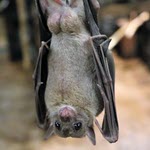Cross-species potential of H9N2 bat flu
In 2009–2010, the first bat-associated Influenza A virus (IAV) was discovered in an asymptomatic little yellow-shouldered bat (Sturnira lilium) in Guatemala. This new virus (A/bat/Guat/2009) has subsequently been classified as a separate subtype, A(H17N10) (1). In 2010, another bat-associated influenza virus, A/bat/Peru/2010, was detected in asymptomatic New World flat-faced fruit bats (Artibeus planirostris) in Peru. This virus also could not be classified as any of the existing IAV subtypes, including A(H17N10), and was therefore classified as A(H18N11)(1).
In 2017, a novel IAV (A/bat/Egypt/381OP/2017) was isolated in Egypt from Egyptian fruit bats (Rousettus aegyptiacus)(2). This virus represented a distinct HA and NA lineage within the A(H9N2) subtype. A/bat/Egypt/381OP/2017 was primarily detected in oral swabs and, unlike the previous bat influenza viruses, was successfully isolated in chicken eggs.
In a new study, researchers extensively characterized the A/bat/Egypt/381OP/2017 virus to identify the capacity of bats to act as an intermediate host, selecting for viral traits associated with mammalian influenza viruses. The results show that, although the bat A(H9N2)-like virus binds preferentially and strongly to α2,3 glycans, a property associated with avian influenza viruses, it is capable of infecting ex vivo human respiratory cell cultures and replicating in the lungs of mice and in the upper respiratory tract of ferrets, properties associated with human influenza viruses. The capacity of the virus to transmit between ferrets and its HA stability profile indicate a certain level of zoonotic threat.
1. Yang W, Schountz T, Ma W. Bat influenza viruses: current status and perspective. Viruses. 2021 Mar 25;13(4):547.
2. Kandeil A, Gomaa MR, Shehata MM, El Taweel AN, Mahmoud SH, Bagato O, Moatasim Y, Kutkat O, Kayed AS, Dawson P, Qiu X. Isolation and characterization of a distinct influenza A virus from Egyptian bats. Journal of virology. 2019 Jan 15;93(2):10-128.











